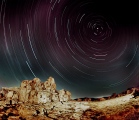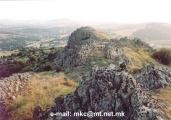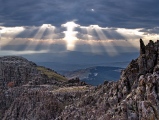Кокино е најстара култура на Балканот
На планинските врвови во Кумановско-кратовскиот регион, покрај реките Пчиња и Крива Река откриена е мрежа од 10 светилишта, кои се материјални докази дека пред 40 века на тие простори имало организиран живот истовремено со Минојците и со Хитите
Кокино не е само опсерваторија, туку и светилиште и култура на луѓе што живееле во бронзениот период, од 18 до 20 век пред наша ера, истовремено со Минојците на Крит и со Хититите во Анадолија. Тоа го изјави Ѓоре Ценев, раководител на истражувањата на теренот во североисточна Македонија, на вчерашната прес-конференција во Скопје, јави МИА.
Интензивните теренски анализи во изминатите два месеца резултирале со откривање мрежа од 10 светилишта на планинските врвови во Кумановско-кратовскиот регион, покрај реките Пчиња и Крива Река, кои се материјални докази дека пред 40 века на тие простори имало организиран живот.
Според Ценев, откритието има големо значење за аргументирање на времето, просторот на живеење и на цивилизацијата што ги направила.
- Преку археоастрономската анализа на Кокино и карактеристиките на овие светилишта, кои ги споредуваме со искуствата на светската наука, може да кажеме дека цивилизацијата што го изградила Кокино постоела во 18, 19 и 20 век пред нашата ера. Луѓето кои го изградиле и кои го користеле Кокино и сите овие светилишта постоеле во тоа време и на оваа територија. Сега слободно може да зборуваме за Кокино култура, што го одликувала тој народ. Ние немаме други такви траги на Балканскиот Полуостров и први сме на овие простори- изјави Ценев.
Според него, откритието е значајно за воспоставување континуитет во аргументацијата за развој на цивилизацијата на територијата на Македонија и на Балканот.
- Има голема културна поврзаност и претставува единство со, во науката дефинираниот простор на, источниот Медитеран и Мала Азија, а нема големи влијанија од север - истакна Ценев.
Тој посочи дека во Кокино цивилизацијата има и карактеристики на кралство, зашто во светилиштата се негувал култот на богот на Сонцето и на бурата, но и на други божества. Постојат камени претстави на животни, особено на орелот кој се поврзува со бурата, и на желката, која е симбол на Земјата, како и издлабени кругови што го симболизираат Сонцето.
Самата опсерваторија на Кокино, која служела како календар за мерење на времето, е меѓу главните дострели на интелектуалните и духовните капацитети на таа култура. Во околината има и најмалку десет археолошки локалитети од бронзениот период со фигурини на луѓе и на животни.
Ценев се надева дека цивилизацијата имала и свое писмо и ако тоа биде откриено, тогаш Кокино ќе ги исполни сите критериуми за да се смета за древна цивилизација, најстара на Балканот.
Од годинава Кокино е на привремената листа на УНЕСКО како археоастрономски локалитет, а за да влезе во листата на ОН со светско културно наследство потребна е комплексна документација, што ќе вклучи научници од различни области.
Google Translation:
Kokkino is the oldest culture in the Balkans
Mountain peaks in the Kumanovo-Kratovo region, despite the rivers Pcinja Kriva Reka and discovered a network of 10 temples, which are tangible evidence that the Century 40 of those spaces were organized simultaneously with the life and Minojcite Hitite
Kokkino is not just an observatory, but a sanctuary and culture of people who lived in the bronze period, from 18 to 20 century BC, while the Minojcite of Crete and Hititite in Anatolia. That said Cenev Gore, head of research in the field in northeastern Macedonia, in yesterday's press conference in Skopje, MIA.
Intensive field tests in the past two months resulted in the detection network of 10 temples on the mountain peaks in the Kumanovo-Kratovo region, despite the rivers Pcinja and Kriva Reka, which are tangible evidence that the Century 40 of those spaces were organized life.
According Cenev, the discovery has great significance for the argument of time, space of life and civilization that have made.
- By arheoastronomskata Kokino analysis and features of these temples, which compare the experiences of world science can say that the civilization that built Kokino existed in 18, 19 and 20 centuries before our era. People who have built and used by Kokino all these temples existed at the time of this territory. Now you can freely talk about Kokino culture that characterized the nation. We have such other traces of the Balkan Peninsula and are the first of these space-Cenev said.
According to him, the discovery is important to establish continuity in the argument for the development of civilization in the territory of Macedonia and the Balkans.
- We have a great relationship and a cultural unity with in the defined area of science, the eastern Mediterranean and Asia Minor, and no major impacts from the north - said Cenev.
He suggested that in Kokkino civilization has characteristics of the Kingdom, because the svetilishtata be nurtured the cult of the god of sun and storm, and other deities. There are stone representations of animals, especially the eagle, which is associated with the storm, and the turtle, which is the symbol of the country and izdlabeni circles symbolize the sun.
The Observatory of Kokkino, who served as a calendar for measuring time, is among the major achievements of the intellectual and spiritual capacities of that culture. The environment has at least ten archaeological bronze objects from the period with figurines of people and animals.
Cenev hopes civilization and had his letter, and if found, then Kokino will meet all criteria to be considered an ancient civilization, the oldest in the Balkans.
Kokkino is the year of the interim list of UNESCO as arheoastronomski site, and to enter a UN list of world heritage documentation required is complex, which will include scientists from different fields.
На планинските врвови во Кумановско-кратовскиот регион, покрај реките Пчиња и Крива Река откриена е мрежа од 10 светилишта, кои се материјални докази дека пред 40 века на тие простори имало организиран живот истовремено со Минојците и со Хитите
Кокино не е само опсерваторија, туку и светилиште и култура на луѓе што живееле во бронзениот период, од 18 до 20 век пред наша ера, истовремено со Минојците на Крит и со Хититите во Анадолија. Тоа го изјави Ѓоре Ценев, раководител на истражувањата на теренот во североисточна Македонија, на вчерашната прес-конференција во Скопје, јави МИА.
Интензивните теренски анализи во изминатите два месеца резултирале со откривање мрежа од 10 светилишта на планинските врвови во Кумановско-кратовскиот регион, покрај реките Пчиња и Крива Река, кои се материјални докази дека пред 40 века на тие простори имало организиран живот.
Според Ценев, откритието има големо значење за аргументирање на времето, просторот на живеење и на цивилизацијата што ги направила.
- Преку археоастрономската анализа на Кокино и карактеристиките на овие светилишта, кои ги споредуваме со искуствата на светската наука, може да кажеме дека цивилизацијата што го изградила Кокино постоела во 18, 19 и 20 век пред нашата ера. Луѓето кои го изградиле и кои го користеле Кокино и сите овие светилишта постоеле во тоа време и на оваа територија. Сега слободно може да зборуваме за Кокино култура, што го одликувала тој народ. Ние немаме други такви траги на Балканскиот Полуостров и први сме на овие простори- изјави Ценев.
Според него, откритието е значајно за воспоставување континуитет во аргументацијата за развој на цивилизацијата на територијата на Македонија и на Балканот.
- Има голема културна поврзаност и претставува единство со, во науката дефинираниот простор на, источниот Медитеран и Мала Азија, а нема големи влијанија од север - истакна Ценев.
Тој посочи дека во Кокино цивилизацијата има и карактеристики на кралство, зашто во светилиштата се негувал култот на богот на Сонцето и на бурата, но и на други божества. Постојат камени претстави на животни, особено на орелот кој се поврзува со бурата, и на желката, која е симбол на Земјата, како и издлабени кругови што го симболизираат Сонцето.
Самата опсерваторија на Кокино, која служела како календар за мерење на времето, е меѓу главните дострели на интелектуалните и духовните капацитети на таа култура. Во околината има и најмалку десет археолошки локалитети од бронзениот период со фигурини на луѓе и на животни.
Ценев се надева дека цивилизацијата имала и свое писмо и ако тоа биде откриено, тогаш Кокино ќе ги исполни сите критериуми за да се смета за древна цивилизација, најстара на Балканот.
Од годинава Кокино е на привремената листа на УНЕСКО како археоастрономски локалитет, а за да влезе во листата на ОН со светско културно наследство потребна е комплексна документација, што ќе вклучи научници од различни области.
Google Translation:
Kokkino is the oldest culture in the Balkans
Mountain peaks in the Kumanovo-Kratovo region, despite the rivers Pcinja Kriva Reka and discovered a network of 10 temples, which are tangible evidence that the Century 40 of those spaces were organized simultaneously with the life and Minojcite Hitite
Kokkino is not just an observatory, but a sanctuary and culture of people who lived in the bronze period, from 18 to 20 century BC, while the Minojcite of Crete and Hititite in Anatolia. That said Cenev Gore, head of research in the field in northeastern Macedonia, in yesterday's press conference in Skopje, MIA.
Intensive field tests in the past two months resulted in the detection network of 10 temples on the mountain peaks in the Kumanovo-Kratovo region, despite the rivers Pcinja and Kriva Reka, which are tangible evidence that the Century 40 of those spaces were organized life.
According Cenev, the discovery has great significance for the argument of time, space of life and civilization that have made.
- By arheoastronomskata Kokino analysis and features of these temples, which compare the experiences of world science can say that the civilization that built Kokino existed in 18, 19 and 20 centuries before our era. People who have built and used by Kokino all these temples existed at the time of this territory. Now you can freely talk about Kokino culture that characterized the nation. We have such other traces of the Balkan Peninsula and are the first of these space-Cenev said.
According to him, the discovery is important to establish continuity in the argument for the development of civilization in the territory of Macedonia and the Balkans.
- We have a great relationship and a cultural unity with in the defined area of science, the eastern Mediterranean and Asia Minor, and no major impacts from the north - said Cenev.
He suggested that in Kokkino civilization has characteristics of the Kingdom, because the svetilishtata be nurtured the cult of the god of sun and storm, and other deities. There are stone representations of animals, especially the eagle, which is associated with the storm, and the turtle, which is the symbol of the country and izdlabeni circles symbolize the sun.
The Observatory of Kokkino, who served as a calendar for measuring time, is among the major achievements of the intellectual and spiritual capacities of that culture. The environment has at least ten archaeological bronze objects from the period with figurines of people and animals.
Cenev hopes civilization and had his letter, and if found, then Kokino will meet all criteria to be considered an ancient civilization, the oldest in the Balkans.
Kokkino is the year of the interim list of UNESCO as arheoastronomski site, and to enter a UN list of world heritage documentation required is complex, which will include scientists from different fields.
































Comment